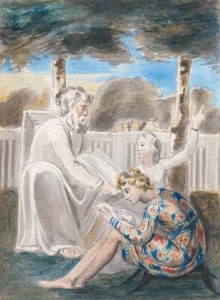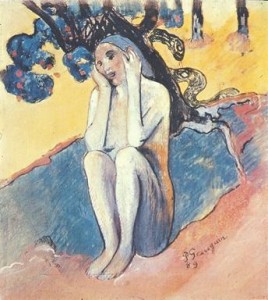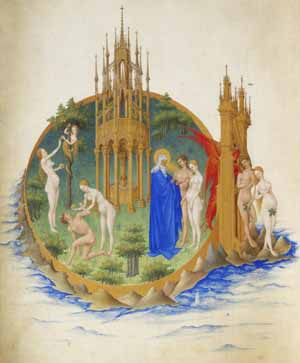Before I forget and these connections are lost in the mists of time, I just wanted to add a link to Ken Parille’s lucid explanation of the attractions of The Book of Genesis. Some notable excerpts:
“The fundamental achievement of Crumb’s Genesis for me is that it avoids something that’s central to so many illustrated versions of the bible or representations of biblical scenes: Crumb rarely idealizes his subject matter. He is not creating an inspirational text, a magical text, or a sympathetic mythology — nor is he mocking the bible. The wonder of Crumb’s Genesis is not the unknowable wonder of God’s ways but of people’s actions as the bible recounts them. If there is reverence in Crumb’s work, it’s for the flesh, for the materiality, both ugly and beautiful (though more often ugly), of biblical characters and the things they do.”
” I feel a greater sympathy with Crumb’s strategy than I do with, say, Michelangelo’s. In its refusal to idealize, Crumb’s seems more ‘real’ to me. The thickness and gritty texture of Crumb’s line and character designs (thick legs, thick lips, thick fingers) tell a truth about the Book of Genesis obscured by more reverential approaches. (It’s almost as if the medium of cartooning is better than painting for this text . . .)”
“On a thread at Comics Comics Noah Berlatsky asks Tim Hodler: “Do you feel that Crumb’s Genesis can in fact stand next to Blake?” I would answer yes, but you have to be clear about the grounds of the comparison. And as the above images show, Blake and Crumb — at times — have a similar coarseness to their work that connects them and their methods as it distances them from Michelangelo. But as a mythologist, Blake’s work, like Michelangelo’s, is often more idealized and lyrical than Crumb’s. Perhaps coarsely put, Blake is metaphysical and Crumb is physical; but even this doesn’t prevent them from participating in a related tradition of religious iconography.
I think Ken’s explanation of the differences between Crumb and Blake is correct (please read his blog for the full explanation). His take on Crumb’s Genesis – its “reverence” for the flesh and the ugliness of some biblical characters – has some similarities to those of Jeet Heer and Alex Buchet.
These points while easy enough to perceive are difficult for me to appreciate or value highly on a conceptual or aesthetic level. There is the quite understandable assumption (not Parille’s I should add) that the ugliness of Genesis isn’t apparent to readers (religious or otherwise) who have lived with Genesis for a reasonable amount of time. The truth is, the materiality of Genesis is something which dedicated readers have had to grapple with as a matter of course: the nature of the “actors”, their apparent strangeness and barbarity. If anything, Crumb’s adaptation seems strangely delicate at times. From his statements concerning the comic, this may even have been intentional. I would say that the terrible nature (some would say sheer cruelty) of the divine is far more “problematic” for those who see Genesis as a religious text, not the base nature of the people and patriarchs who inhabit it; a very real and very flawed humanity is almost an expectation for many readers.
Perhaps my greatest problem with the course advocated by Ken is that I am insufficiently moved by the novelty of Crumb’s “physicality” to put aside my issues with the comic’s intellectual content (which I find lacking). I find Hugo van der Goes depiction of Adam and Even much stranger in this regard despite the painting’s considerable age. One could also look to Gauguin or Redon and their depictions of Eve for yet another path through this familiar territory. I understand the thrill of seeing a master cartoonist applying his craft to time honored themes but my interest in Crumb’s work lies only partially in his unique but largely unchanging method of depicting the human body.
Crumb’s illustrations assume a sort of perfection of human form and behavior as far as Adam and Eve are concerned. I presume that this is one example of the “beautiful” materiality of The Book of Genesis which Ken mentions in the excerpt above. There is certainly a degree of exaggeration and a filtering through the artist’s eye but this is not a particularly earthy version of Eden. The interactions we find in this temporary paradise are innocent and child-like in deference to the text. This relates to the respectful part of Crumb’s “respectful de-mystification” which Ken mentions in the comments on his blog. There is very little of that grimy commonness which we see in the Gospel adaptations of Pasolini or Chester Brown. The subversive element of presenting God as a man (the oldest patriarch as Crumb puts it) seems to have been adequately undertaken by Michelangelo and his predecessors. These images have been embraced by a number of Christians but it is only in more recent times that this understanding of imago dei (i.e. its corporeal nature; an idea which is far from widely accepted) has gained purchase among scholars (see Gerhard von Rad and Umberto Cassuto here and on page 7 of the PDF file here).
The problem with Crumb’s “respectful demystification” is that it results in a watering down as far as much of Genesis is concerned. This approach is perfectly serviceable if occasionally dull when recounting the story of Dinah (as mentioned in my original posting) but severely hobbled when interpreting the frankly mystical parts of Genesis (such as the stories surrounding the creation and flood). Here the middle road of plain, commonsensical transcription can only be accounted inferior to the other extremes on the scale because of the sheer pervasiveness of the former images in popular culture. The opening account of creation and fall (Genesis 2 and 3) which to irreligious eyes can only be viewed as poppycock therefore resembles little more than a Sunday School tale. This neutering of the text frequently occurs when the story of creation is explained to children.
The long and short of this is that I just don’t find Crumb’s conception of the text as interesting as those by Michelangelo and Blake (his overtly heretical mythologies), or others predicated on biblical scholarship. It’s a difference of opinion which I can easily accept and I would like to thank Ken for explaining the opposing opinion in such concise terms.
____________
Update by Noah: A whole series of posts on Crumb’s Genesis can be found here.





I would say that the terrible nature (some would say sheer cruelty) of the divine is far more “problematic” for those who see Genesis as a religious text, not the base nature of the people and patriarchs who inhabit it; a very real and very flawed humanity is almost an expectation for many readers.
My own view of it is that Genesis sets the stage for Exodus and the establishment of codified law with the Decalogue. It’s an interesting juggling act on the part of the J writer. The injustice of arbitrary authority is fully dramatized by God’s actions in Genesis, but the J writer still asserts God’s prerogative to be arbitrary. The Decalogue exists because God will not allow humanity to deal with each other in the same way.
My thoughts on Genesis and Exodus are here and here. These aren’t commentaries on Crumb, by the way; they’re my take on the scriptures, written back in 2008.
Suat,
This is a great post – and thanks for responding.
“There is the quite understandable assumption (not Parille’s I should add) that the ugliness of Genesis isn’t apparent to readers (religious or otherwise) who have lived with Genesis for a reasonable amount of time.”
I have heard/seen people talk about the ugliness of Genesis, but they have framed it, ultimately, in moral — not visual — terms. The visual contexts (film, painting) in which I have seen such morality dramatized have often put a kind of halo over such ethical questions. The accompanying visuals tend to affirm some greater mystery, to assert the metaphysical grandeur even as they expose the darkness of human motivations (in fact, the ugliness of human actions makes ‘the mystery’ even grander by comparison).
I see Crumb’s Genesis as somewhat morally neutral, though not interpretively neutral. I think you can be the former to some degree, but not the latter (you are, of course, always adding images that are not in the text).
“The problem with Crumb’s “respectful demystification” is that it results in a watering down as far as much of Genesis is concerned. This approach is perfectly serviceable if occasionally dull when recounting the story of Dinah (as mentioned in my original posting) but severely hobbled when interpreting the frankly mystical parts of Genesis (such as the stories surrounding the creation . . .”
Here we come to a subjective impasse: Page one to me is beautiful, a literalized mysticism that I find appealing: this is what world-making might look like.
Another successful scene: The domestic pastoral tableaux that opens chapter 2 – alongside of Adam, Eve, and a few birds and rabbits, God rests against a tree after creation, hands on his knees, eyes closed. I can’t quite explain why, but the decision to show God resting against a tree this way is a very moving and unexpected choice; God seems strangely human and naturalized, just after his world-creating supernatural powers have been demonstrated. There is a little idealizing at work in this pastoral quality of this panel, but it is of a very earth-bound, domestic kind.
Hi, Ken. The idea that Crumb’s Genesis is “morally netural” (do you mean spiritually neutral?) is rather interesting. I suppose your first point is referring to the way some Christians might use a story from Genesis to illustrate a moral point while Crumb is more interested in the earthiness (or physical ugliness) of these humans and their environments. Your second point follows on this by saying that other visual adaptations have framed these actions in reference to deity, a sort of idealization of these moments. So it’s the realism of this undertaking, its almost historical, perhaps near documentary-like tone which you sense and appreciate. I don’t know if this amounts to a moral neutrality.
Assuming that it is, it may be possible in the later sections of Genesis (less so the earlier parts) though it requires some degree of separation of text and image in the reading process. The text is so open that the reader has to insinuate himself into the whole process whatever the intentions of the artist. As such It is difficult to see the comic as being morally (as in ethically) neutral given the stories being depicted (murder, incest etc.). Nevertheless, worth thinking about.
I’m responding to Suat down in his original thread, if anyone would care to join me.
Suat,
I would say it’s neutral in the sense that it feels like the text — though perhaps not Crumb himself — neither celebrates nor mocks the source and it spirituality or its supernaturalism: in general, the adapation doesn’t pass a moral judgement on the original taken as a whole.
You could argue that every adapation of a such a book must have some kind of ethical component, but in this case it seems pretty minimal to me.
“So it’s the realism of this undertaking, its almost historical, perhaps near documentary-like tone which you sense and appreciate.”
I would agree with this in a way, though much of what I like about the text is its cartoony look; so realism might not be the correct word for me.
“Blake is metaphysical; Crumb is purely physical”–well put.